Share this link via
Or copy link
One of the best Japanese Kanji dictionary.

Rice is a staple food in Japan. According to the Ministry of Agriculture, Forestry and Fisheries(MAFF), about 8,607,000 tons of rice were produced in 2013. Its Kanji is 米(kome), and sometimes called お米(okome). However, there is a confusing word ご飯(gohan), meaning both “cooked rice” and “meal.” You need to guess which meaning the speaker is using by the context. By the way, the unit used to count the bowl of cooked rice is 膳(zen) or 杯(hai).
Contents
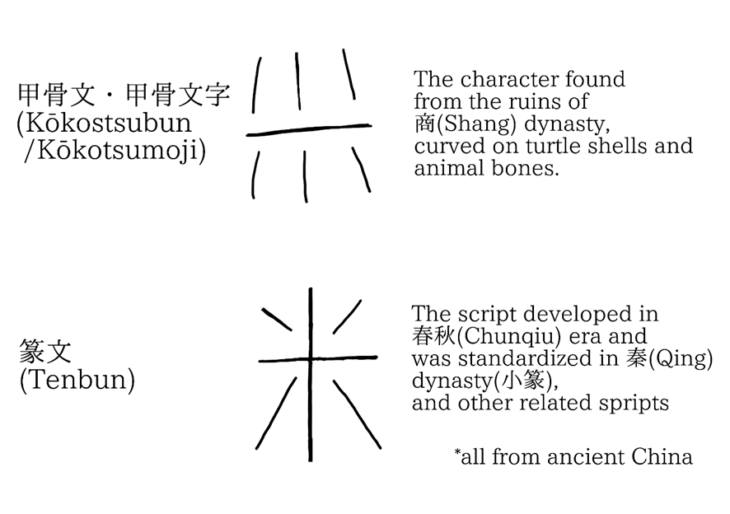
The horizontal line used in 甲骨文 is the branch of the ear of the rice. Six dots represent the grains.
米 is also used as a radical. It is used for characters about the characteristics of rice, various kinds of rice and grains, and processed food of those.
Here are some examples of the characters.
The character 米 could be separated to 八(eight) and 十(ten) and 八. Eighty-eight is pronounced “hachijūhachi”  and written 八十八 when using Kanji. Therefore, the longevity celebration for getting 88 years old is called 米寿. 寿 means longevity.
and written 八十八 when using Kanji. Therefore, the longevity celebration for getting 88 years old is called 米寿. 寿 means longevity.
Some people are told that “Seven gods are living in one grain of rice” in their childhood. This is a proverb to describe how precious the rice is and used to teach children that they have to eat rice to the last grain.
Small children are not good at using chopsticks yet and tend to leave some grains of rice. Parents have to teach children that rice is very precious, and everyone has to eat to the last grain. Instead, some people are told, “If you don’t eat rice to the last grain, you will lose your sight.” or “The farmer will scold you if you waste rice.”
Rice cooker is called 炊飯器(suihanki)  in Japanese. 「炊飯」is a noun meaning “to cook rice.”
in Japanese. 「炊飯」is a noun meaning “to cook rice.”
“炊く”(taku) is a particular verb used for cooking rice. 飯(han in Onyomi, meshi in Kunyomi) means “cooked rice.” 器(ki) means “tool” in this context.
Let me show you how to cook rice with 炊飯器.
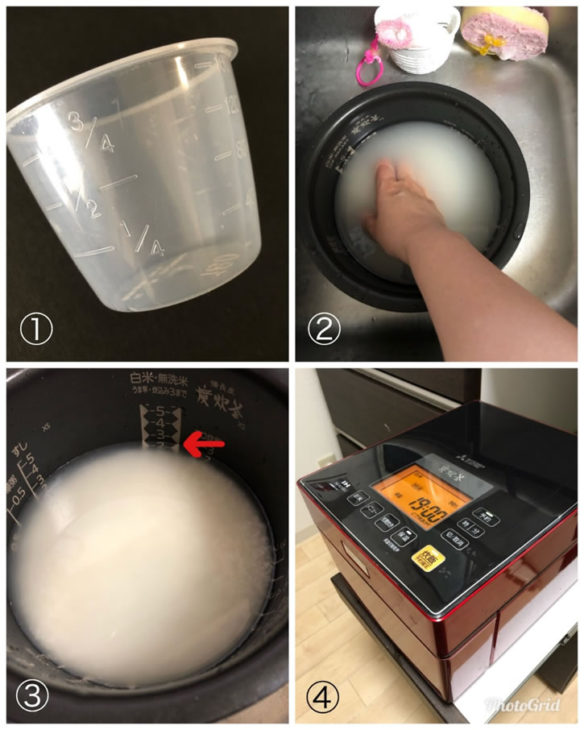
Even if you come to Japan and buy an excellent rice cooker, you can’t use it if you don’t understand the functions.
The rice cooker used as an example here is Mitsubishi steamless IH jar rice cooker NJ-XS105J. However, the buttons are pretty much the same as other rice cookers.
First, select the rice type with 「お米」(okome) button. 「お米」simply means “rice.” You can choose from white rice, pre-washed rice (the one you don’t have to wash by yourself), and brown rice.
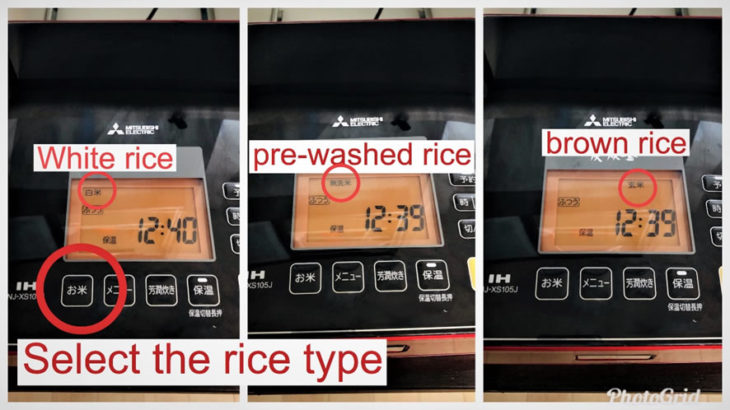
Then, push the メニュー(menyū) button several times to select the texture of rice and the cooking method.
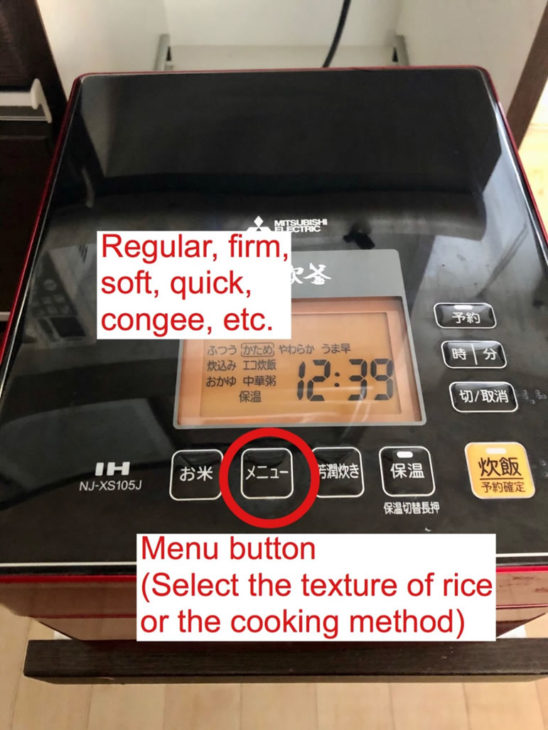
You can select the texture from three options,「ふつう」(futsū, regular)「かため」(katame, firm),「やわらか」(yawaraka, soft).
You push「うま早」(umahaya) when you want to cook rice in a short time.「うまい」(umai) means tasty and「早い」(hayai) means fast. By using this rice cooker, it usually takes about 55 minutes to cook. However, if you use this function, it will be shortened to 29 minutes. But this is probably the word used only for Mitsubishi Electric’s products. Maybe you will find the word「お急ぎ」(oisogi) on other manufacturer’s rice cookers for the same function.
「炊込み」(takikomi) is for making 炊き込みご飯(takikomigohan). Choose this when you want to cook rice with seasonings and various ingredients together.
「おかゆ」(okayu) is for making Japanese rice porridge(congee) and 「中華粥」(chūkagayu) is for making Chinese rice porridge. (Both dishes is explained below.)
If you want to make a reservation, push the 予約(yoyaku) button and select what time you would like the rice to be cooked. 予約 means “reservation,” 時(ji) is for the hour, and 分(fun) is for the minute.
If you want to cook rice right away, you don’t need to touch the予約 button. Press the「炊飯」(suihan) button to start cooking.
If you want to stop or cancel, or turn the rice cooker off, press the「切/取消」button. You use the verb 「入れる」(ireru) to turn the power(電源, dengen) on, and「切る」(kiru) to turn it off. 「取り消し」(torikeshi) means to cancel.
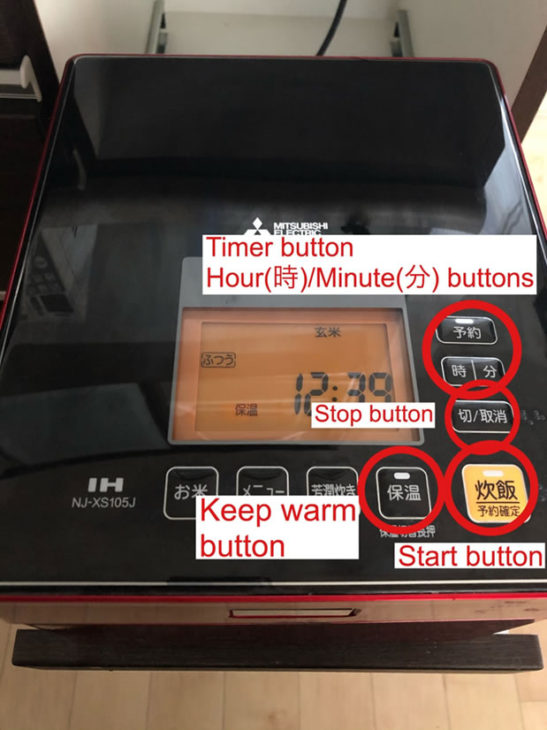
Most Japanese cook rice with 炊飯器. However, you can cook rice without it too. Here is a video that shows how to cook rice with a pot.
Steamed Rice Recipe – Japanese Cooking 101
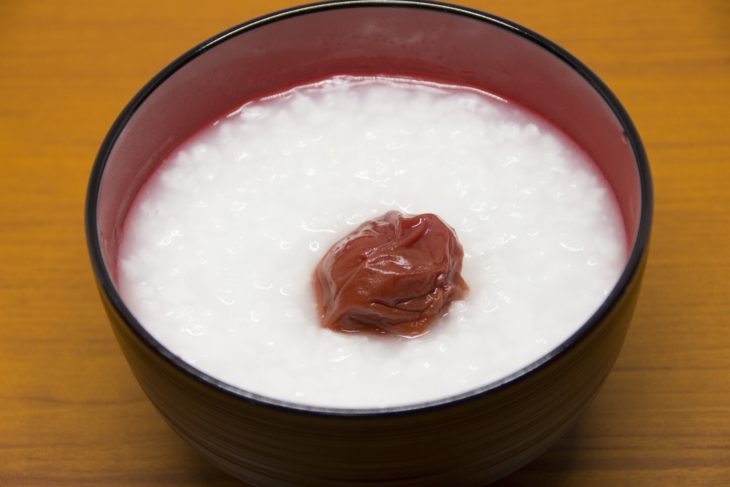
Rice porridge or congee is a dish easy on your stomach. The name “congee” comes from a derivation of the Tamil word கஞ்சி(Kañci; Kanji), and there is no relationship with Japanese Kanji. It is called お粥(okayu) in Japanese.
You can cook it with 炊飯器 or a pot. Here is a video about how to cook お粥 with a pot without using a rice cooker.
Okayu (Japanese Rice Porridge) Recipe – Japanese Cooking 101
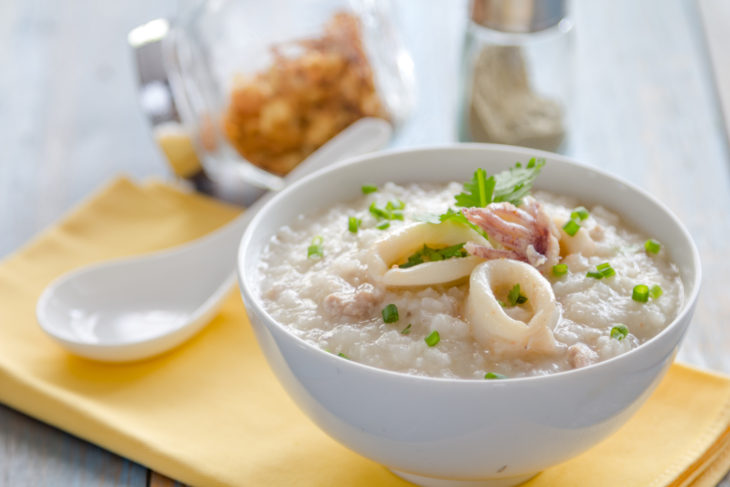
rice porridge with shrimp, squid on white table
There is a dish called 中華粥(chūkagayu), literally meaning “Chinese rice porridge.” It is not certain how much it is true to the rice porridge eaten in China, but the Japanese people call this dish 中華粥.
Ordinary お粥has an image of a dish for sick people but 中華粥is different. It is something to enjoy its taste. Usually, you boil the rice with soup taken from chicken bones or fish bones and put various kinds of toppings such as chicken meat, shrimp, ginger, spring onions, etc.
Do you think it’s time-consuming to take the soup from chicken bones? No problem, you can buy a chicken bouillon powder easily at a supermarket.
It is not too much to say that Japanese people cannot live without rice. The variety of Japanese rice, which is called Japonica rice, is different from the majority of rice produced in the world, which is called Indica rice. Therefore, eating Japanese rice has another joy and fun. Just try freshly cooked Japanese rice with a good main dish and miso soup – you might be captivated by the taste and the harmony of Japanese food!
What is Onyomi?
Onyomi, also known as the "Sino-Japanese reading," is one of the two main reading systems for kanji characters in Japanese. It refers to the reading of a kanji character that is derived from the original Chinese pronunciation.
What is Kunyomi?
Kunyomi, also known as the "native Japanese reading," is one of the two main reading systems for kanji characters in Japanese. It refers to the reading of a kanji character that is based on the native Japanese pronunciation. Kunyomi readings are often used when a kanji character stands alone or is followed by hiragana, as in verbs and adjectives. Mastering both kunyomi and onyomi is crucial for understanding and using kanji effectively in the Japanese language.
What is Radical?
A radical, also known as "bushu" in Japanese, is a fundamental component of kanji characters. Radicals are the building blocks of kanji and are used to categorize and organize them in dictionaries. There are 214 traditional radicals, each with its own meaning, which often provides a clue to the meaning of the kanji character it forms.
What is strokes?
Stroke count, or "kakusuu" in Japanese, refers to the number of individual brushstrokes required to write a kanji character. Each kanji has a specific stroke order and stroke count, which are essential for writing the character correctly and legibly. Understanding and following the correct stroke order not only ensures proper balance and aesthetics but also makes writing more efficient and fluid.